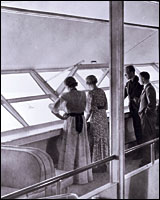
Do hairs go gray overnight? Is a healthy strand of hair (from split-end to follicle) drained of its pigment all at once, or, does an existing, pigmented hair start coming in gray at the root (so you could have a hair that is half your original color and half gray)? The latter seems to be true. With age, the pigment cells in the follicle gradually die off. As they do so, that strand will no longer contain as much color and will show up as silver, gray, or white as it grows. Eventually, all the pigment cells will die and the hair becomes completely white. There is much debate over the claims of people who say that their hair turned white overnight due to an intense shock or prolonged stress. Most scientists don't buy that an existing, pigmented hair can "die" and lose its color in a short period of time, though there are thousands of testimonies to the contrary.
"There is only one cure for gray hair... It is called the guillotine." PG Wodehouse
Henry Gray was born in either 1825 or 27 and he became an anatomist and teacher at St George's Hospital Medical School in London in the 1850s. In 1855 he approached his colleague Dr Henry Vandyke Carter with his idea to produce an Anatomy text book for medical students. The illustrated book is a medical reference, aimed at physicians. It is still published today and is usually referred to as
Gray's Anatomy.
"Gray, dear friend, is all theory. But green the golden tree of life."
Johann Wolfgang Von Goethe
Alex Grey is an artist specializing in spiritual and psychedelic art (or visionary art). I once climbed to the roof of his studio in NY during a spectacular thunderstorm (he was not there). He is also interesting to me because an online search for him lead me to the wonderful world of
Stuckism, an interesting reaction to the postmodern conceptual art boom,consisting of Brits who dare do believe that artists can have souls and make figurative paintings.
And this gray spirit yearning in desire
To follow knowledge like a sinking star,
Beyond the utmost bound of human thought.
Alfred Tennyson
Martin Gray is an anthropologist and photographer specializing in the study of sacred sites and pilgrimage traditions around the world.
"When all candles bee out, all cats be gray." John Heywood
Spalding Gray (June 5, 1941 -– ca. January 10, 2004) was an actor, screenwriter and playwright. Born in Barrington, Rhode Island, he was best known for his performance monologues, which deal with events from his own life in a style characterised by humor, paranoia and acute self-consciousness. On March 7, 2004, the New York City medical examiner's office reported that at 3:00 Spalding Gray's body had been pulled from the East River. In light of a suicide attempt in 2002, and the fact that his mother had taken her own life in 1967, suicide was the suspected cause of death. It was reported that Gray was working on a new monologue at the time of his death, and that the subject matter of the piece - the Ireland car crash and his subsequent attempts to recover from his injuries - might have triggered his final bout of depression.
"All the American women had purple noses and gray lips and their faces were chalk white from terrible powder. I recognized that the U.S. could be my life's work."
Helena Rubinstein
Writer
Francine du Plessix Gray is well-known for both fiction and non-fiction. She has been decorated by the French government as Chevalier de l'Ordre des Arts et des Lettres and is a member of the American Academy of Arts and Letters.
"The choice in politics isn't usually between black and white. It'’s between two horrible shades of gray." Peter Thorneycroft
Obligatory Dorian Gray woodblock print
here.
("Dorian Gray Dandy, #1" painting by
Jarmo Mäkilä)
.







































